A cable machine is easy gym equipment for training legs because it provides smooth, fluid form and content stimulation. With adjustable pulleys and attachments, you can complete the lower body.
Don’t worry; you can do plenty of exercises on the cable machine to build up some serious leg workouts.
I’ve seen good improvements in my leg’s definition and strength after incorporating cable exercises into my workout routine.
They can be performed as cable-only leg workouts or as additions to other leg workouts, but always remember that prioritizing progressive overload is necessary for strength gains.
Here are my 15 favorite leg exercises and some tips to make sure you do them safely and effectively.
Want to take your gains to the next level? Discover your daily calorie needs with our free TDEE calculator
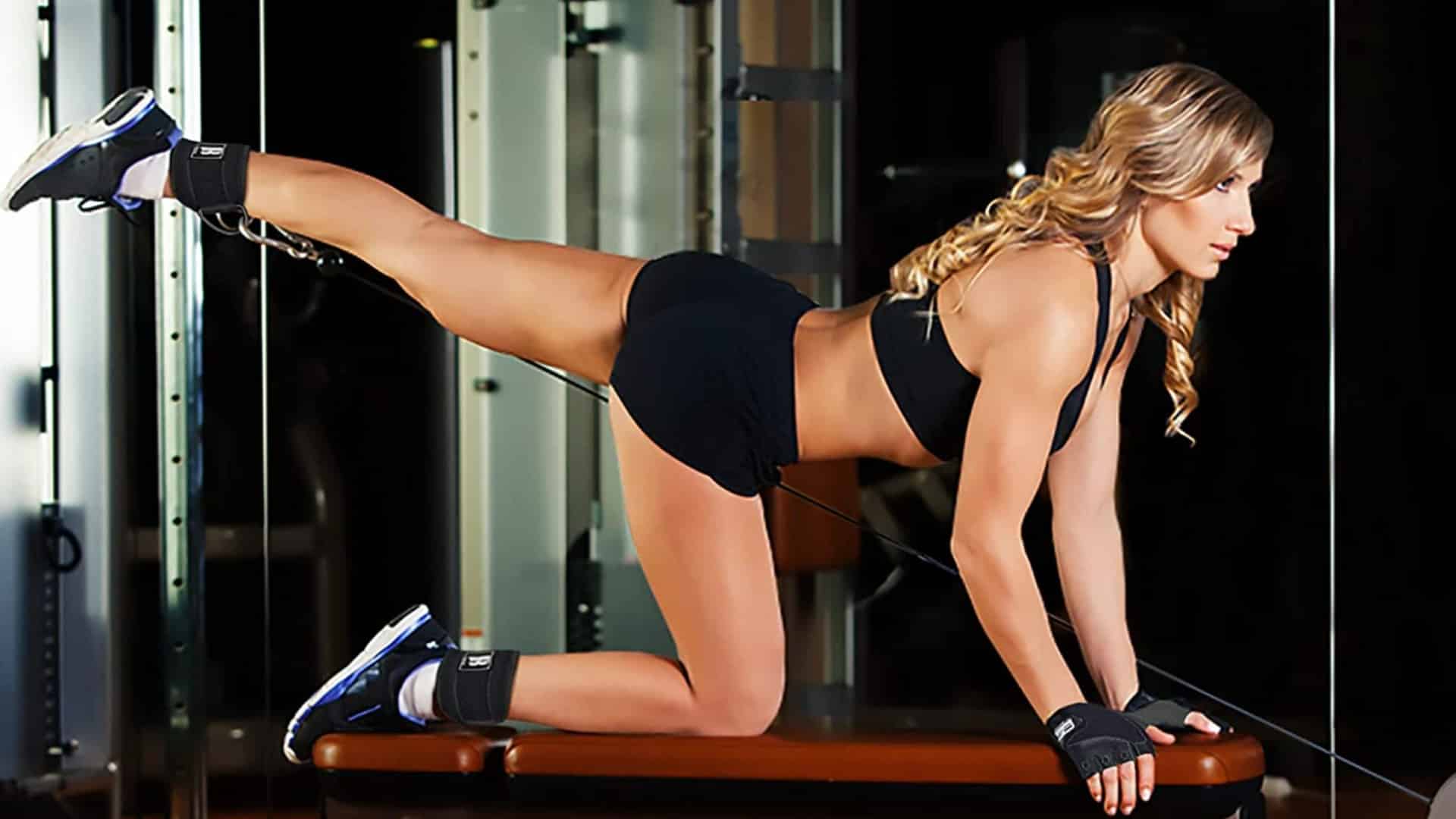
- 15 Best Cable Leg Exercises
- 1. Cable Deadlift
- 2. Cable Squat
- 3. Cable Front Lunges
- 4. Cable Stiff-Leg Deadlift
- 5. Cable Front Squat
- 6. Cable Chair Squat
- 7. Cable Pull-Through
- 8. Cable Step Up
- 9. Cable Standing Leg Curl
- 10. Cable Glute Kickback
- 11. Kneeling Cable Hip Extension
- 12. Cable Standing One Leg Calf Raise
- 13. Cable Standing Calf Raise
- 14. Cable Hip Adduction
- 15. Cable Hip Abduction
- How To Build Leg Cable (With Workout Routines)
- 1. Set And Reps To Mass, Power, And Endurance
- 2. Select Weekly Workout Volume
- 3. Weekly Frequency
- Beginner Cable Leg Workout Routine
- Cable Leg Workout Plan
- Intermediate Leg Cable Workout Routine
- Leg Muscle Anatomy
- Quadriceps
- Hamstrings
- Gluteals
- Calves
- FAQs
- Best Cable machine quad exercises
- Are Cable Leg Exercises Effective?
- Are cable machines effective for leg strength?
- Are you able to perform squats with a cable machine?
- Are leg extensions possible with cables?
- How do you use leg cables at the gym?
- Takeaways
15 Best Cable Leg Exercises
Here are our top 15 cable leg workouts to help you build Bigger and Stronger Legs.
Must try this workout so that you can experience the power of cable machine leg exercises for yourself!
1. Cable Deadlift
The cable deadlift is a fantastic variation of the traditional barbell deadlift. It provides a unique training stimulus and benefits, effectively activating the posterior chain muscles (glutes, hamstrings, lower back).
One of the biggest benefits is that it offers a smooth, controlled motion, giving your muscles almost uninterrupted time under tension and a massive pump.
I started doing cable deadlifts a year ago, and I’m really impressed with the results.
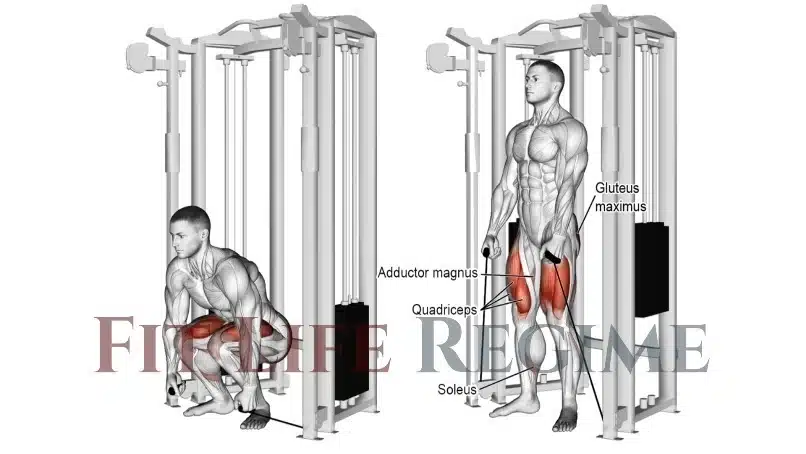
Muscles Worked
Primary: Erector spinae, Gluteals, Hamstrings.
Secondary: Trapezius, Latissimus dorsi, Quadriceps, Forearms.
How To Do Cable Deadlift
- Attach two pulleys at the lowest setting on a cable machine.
- Make sure the cable pulley attachments are located close to each other.
- Keeping your knees slightly bent, hinge forward from your hips, pushing your glutes back. Maintain a neutral spine with your chest up.
- As you lower, feel the stretch in your hamstrings.
- Engage your glutes and hamstrings to drive back to the starting position and squeeze at the top.
- Raise it to the point where your body is erect. Do not hyperextend your body as the weight shifts to the lumbar spine.
Tips
- Do not go through half of the exercise; complete the lift.
- Avoid jerky movements and keep motion controlled.
- You should keep your legs slightly bent, your back straight, and your head looking up.
2. Cable Squat
Cable Squats are an excellent alternative to barbell squats for building quality muscle mass in the legs. When you do this, your quadriceps, gluteus, and core muscles work harder.
Cable squats can be performed using various cable attachments, such as a straight bar, rope, or V-bar. This allows you to target the leg muscles differently, which keeps your workouts fresh and engaging.
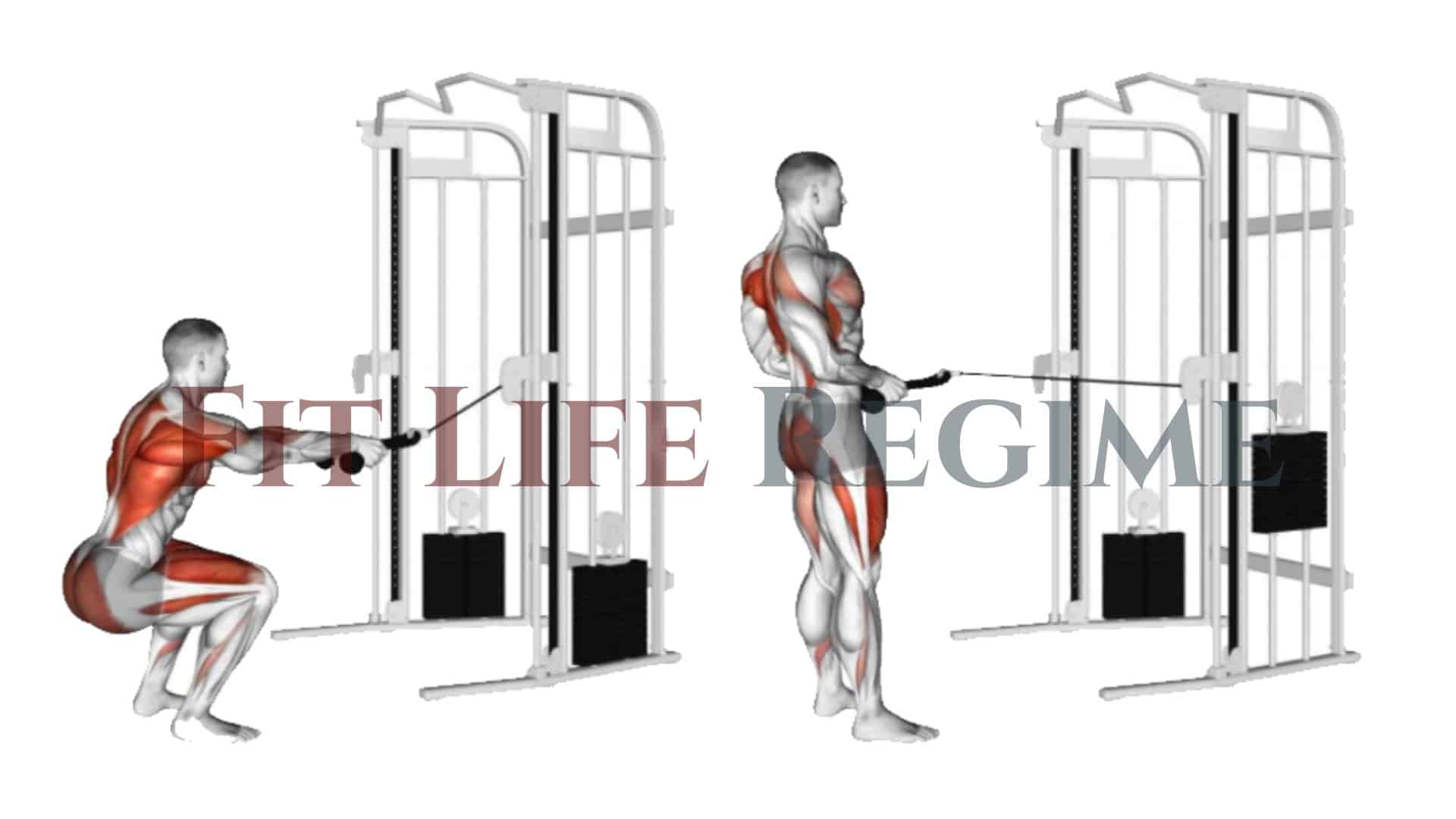
Muscles Worked
Primary: Quadriceps, gluteals.
Secondary: Hamstrings, adductors, spinal erectors, abs.
How To Do Cable Squat
- Grip a cable rope in each hand. Stand away from the cable machine so that the slack tightens.
- Make sure your back is straight and your core is tight.
- Bend your knees and drive your hips back while you keep your chest up.
- Stand back up, then pull the handles back, leading with your elbows.
- Tighten the back muscles, then return the handles to the starting position.
- Repeat the desired number of sets and Reps
Tips
- Keep your torso upright, shoulders back, head up, and feet flat.
- Experiment with different handle attachments to find your preference.
Know More: 10 Best Dumbbell Quad Exercises To Build Mass And Strength
3. Cable Front Lunges
Cable lunges require good balance, so if you have issues keeping your balance, start by doing the lunges exercise without weights as you learn the proper form.
Be careful that the knee of the forward leg does not extend past the toes as you bend the leg. This can aggravate the knee joint if done too much and lead to an injury.
Squeeze your butts at the end of this movement for full benefit. Feet together stance is recommended.
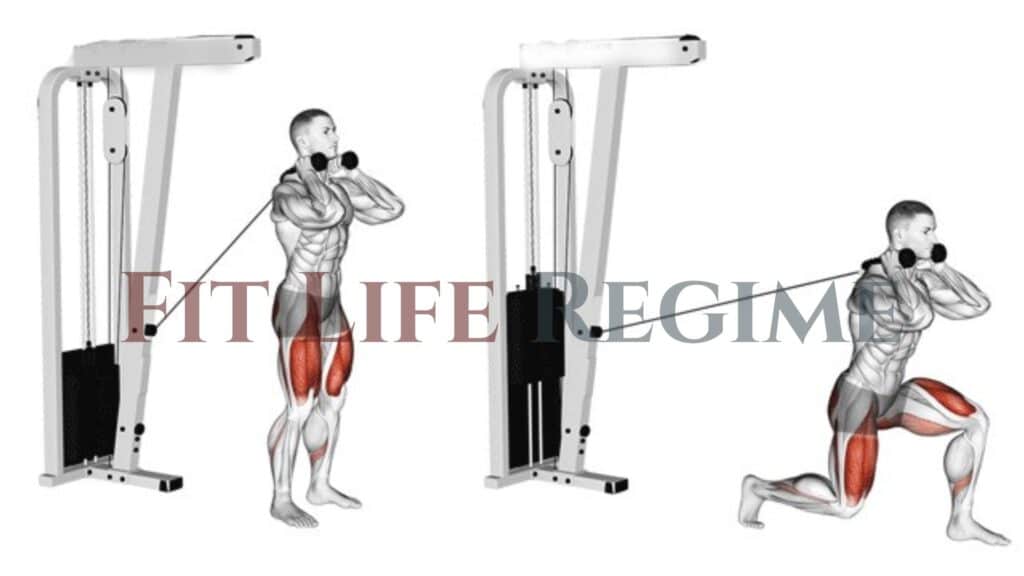
Muscles Worked
Primary: Quadriceps.
Secondary: Gluteals, hamstrings, adductors.
How To Do Cable Front Lunge
- Attach the rope handle and place the cable in the lowest position.
- With your back to the cable machine, grip the rope with both hands.
- The rope will be against your back and at your shoulders.
- Keep your back straight, take a step forward, bend your knees, and get them as close to the floor as possible.
- Push yourself back to the starting position and repeat with the other foot.
- Keep alternating the leg with which you lunge.
Tips
- Bend as far and low as possible without losing form.
- Keep your torso upright and your head facing forward.
4. Cable Stiff-Leg Deadlift
If you’re looking for a straightforward cable leg workout and exercises to build mass and strength in your legs, then cable stiff leg deadlift is a great staple exercise to get you started.
Do it with a lighter weight than that used during traditional powerlifting for strengthening the lower back.
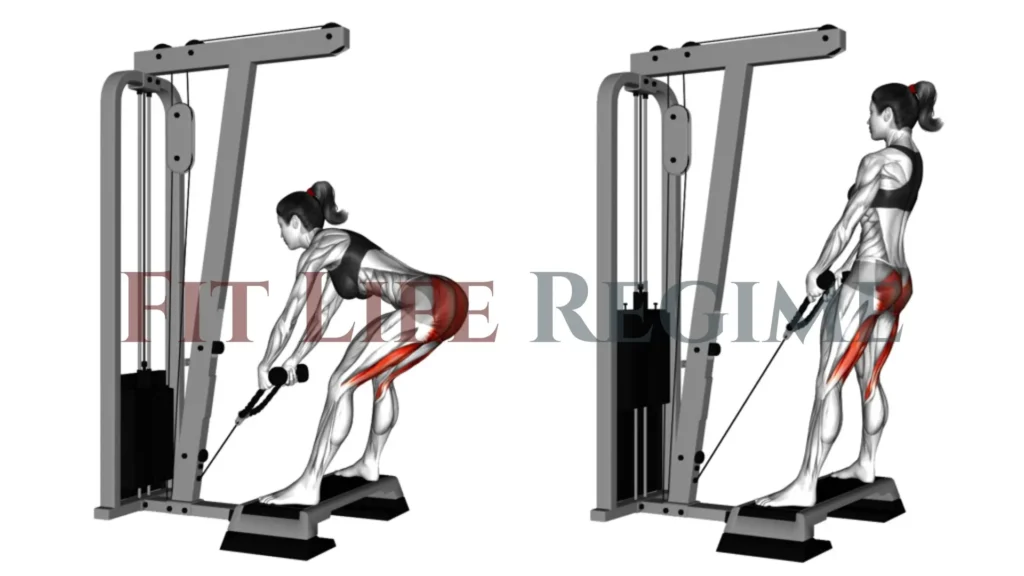
Muscles Worked
Primary: Hamstring, Gluteals.
Secondary: Spinal erectors, Quadriceps.
How To Do Cable Stiff-Leg Deadlift
- Attach the rope handle to the pulley and position at the lowest position.
- Face the pulley with the rope in both hands and about 3 feet of distance between you and the machine.
- Keeping your back straight, head up, and hips low, lift the cable into a standing position.
- Flex your knees a little, push your hips backward, and slowly lower the cable down the front of your legs.
- Descend until you feel a mild stretch in your hamstrings.
- Exhale as you pull the cable back up to the starting position by pushing your hips forward.
Read More To Know More: Dumbbell Leg Exercises To Mass And Strength
5. Cable Front Squat
The squat and the cable front squat work the same target and synergistic muscles. However, the cable front squat recruits more stabilizer muscles, including various back muscles, your shoulders, and chest.
The cable front squat is the best option for a leg workout. It is more advanced than the standard squat. However, it is not as effective at building mass because it doesn’t permit as much weight to be lifted.
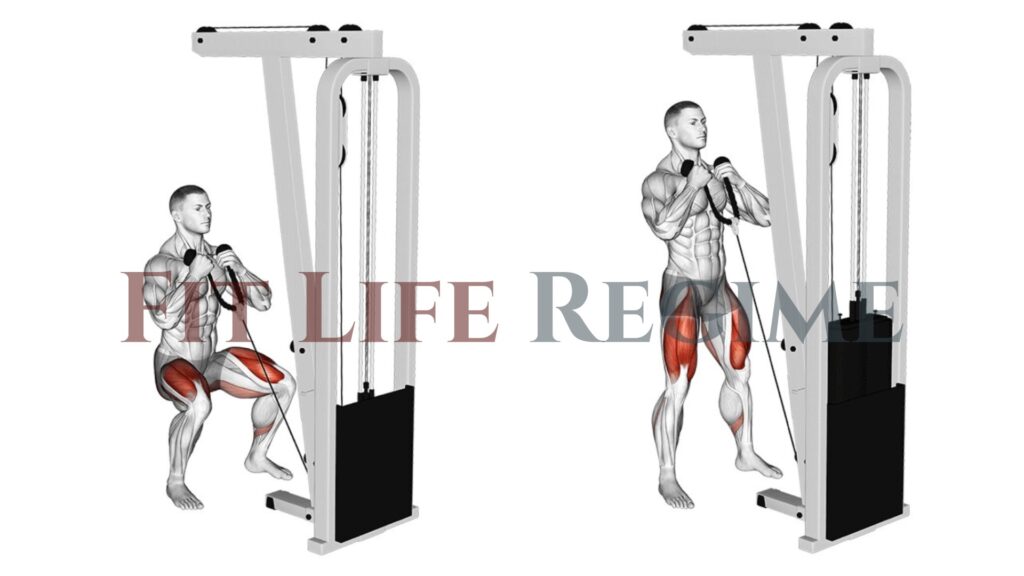
Muscles Worked
Primary: Quadriceps, gluteals.
Secondary: Hamstrings, adductors, spinal erectors, abs
How To Do Front Cable Squat
- Stand in front of a low-pulley cable machine with your feet shoulder-width apart.
- Then, pull the ropes up to your chest and hold.
- Maintain the natural arch in your lower back and keep your head directed forward.
- Perform a squat, bending your knees and pushing your hips back to lower yourself until your thighs parallel the floor.
- From this position, push yourself back to the starting point.
Tips
- Start light and add weight gradually, allowing your legs and lower back time to adapt.
- Lift your chest first and keep your elbows up to prevent the bar from falling.
6. Cable Chair Squat
Cable Chair Squat is also known as Cable Narrow Chair Stand Up.
Due to the load and body position, this exercise is a great way to build up the strength and size in your quads. It involves less pressure on your hips and more resistance at your knees.
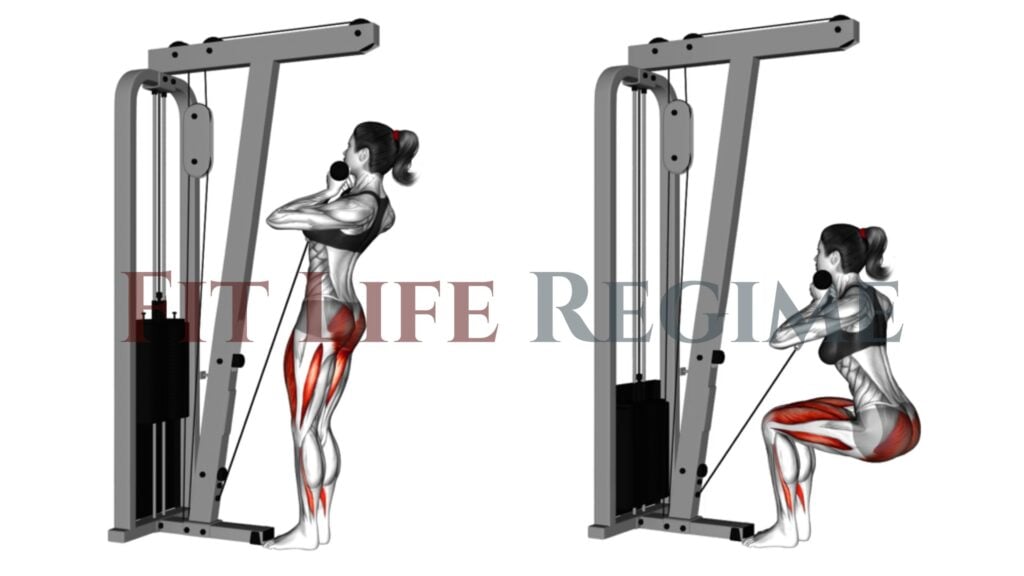
Muscles Worked
Primary: Quadriceps, gluteals.
Secondary: Hamstrings, adductors, spinal erectors, abdominals.
How To Do Front Chair Squat
- Stand in front of a low-pulley cable machine with a narrow stance.
- Then, pull the ropes up to your chest and hold.
- Perform a squat, bending your knees and pushing your hips back to lower yourself until your thighs parallel the floor.
- From this position, push yourself back to the starting point.
- Repeat as many reps and sets to reach your goal.
Tips
- Make sure your back is straight and your core is tight.
- Lift your chest first and keep your elbows up to prevent the bar from falling.
- Keep your knees stiff, your back and arms straight, and your head up.
7. Cable Pull-Through
The Cable Pull-Through is a popular exercise that targets the glutes and hamstrings for muscle and strength-building purposes.
Now, many people are afraid to perform this movement or are just not interested because it requires a little setup and may even look a little funny.
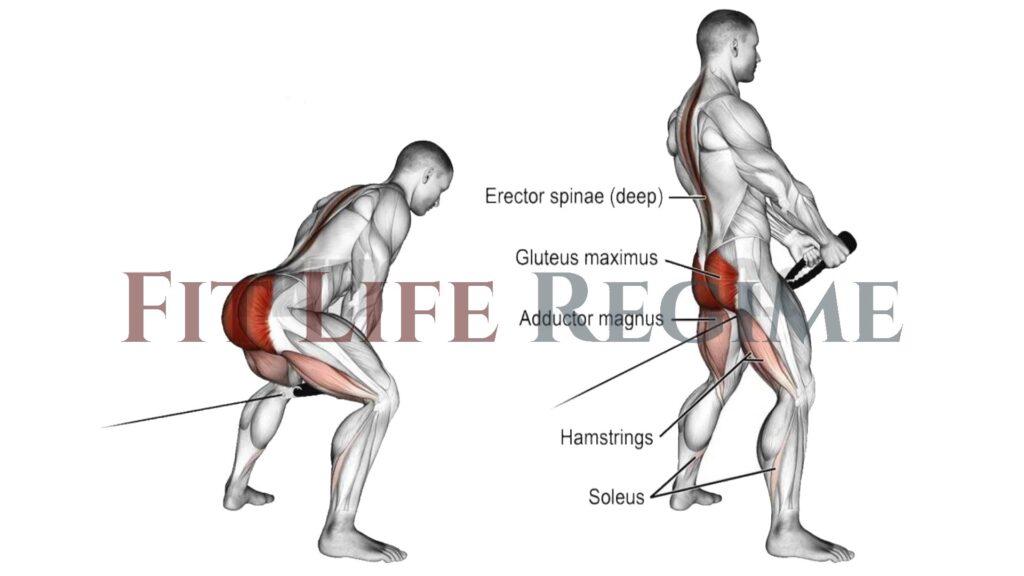
Muscles Worked
Primary: Hamstrings, Gluteus Maximus
Secondary: Quadriceps, Erector Spinae
How To Do Cable Pull-Through
- Grasp the attachment of a low cable pulley. Straddle the cable so that your back faces the pulley.
- Keeping your legs straight, flex your hips and waist until you feel a mild stretch in your hamstrings.
- Step forward until the rope is pulled taut, and stand with your feet shoulder-width apart.
- Keeping your legs and arms straight, exhale as you stand up and pull the cable attachment through your legs.
- Hold for a count of two and squeeze your glutes.
- Inhale as you reverse the motion and return the cable attachment to the starting position with your hips and waist flexed.
Tips
- At the top of the movement, do not hyperextend your back.
- All the movement should occur in your hips.
8. Cable Step Up
The cable step-up is a great leg workout for building lower-body strength and power.
This exercise targets the quadriceps and also involves calves and glutes & hip flexors.
The step-up is a great all-round exercise that is perfect for everyone. It can be modified to create a challenging workout for anyone, whether they have just started exercising or have been training for years.
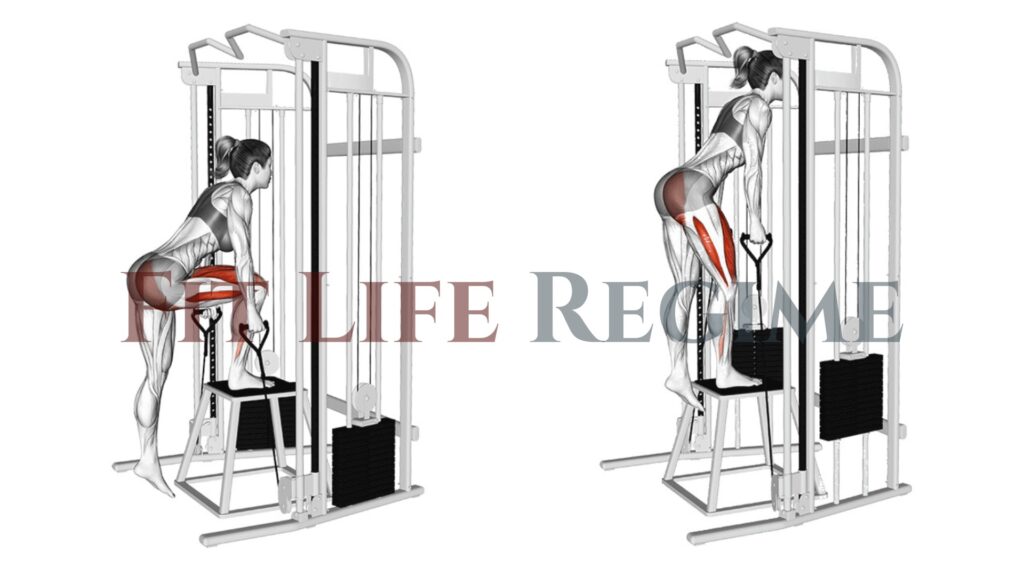
Muscles Worked
Primary: Quadriceps.
Secondary: Gluteals, hamstrings, Soleus, Gastrocnemius
How To Do Cable Step Up
- Place a knee-high box in front of you and grasp the stirrups at each side of the platform in each hand.
- Stand with your feet in a comfortable hip-width stance.
- Step forward with one leg onto the step and drive through that thigh to bring your body upward.
- Bring the trailing leg to the top of the step and stand on the box.
- Then, step back with the opposite leg to the floor and lower yourself.
- Alternate legs with each rep.
Tips
- Control the movement, using your muscles to lift and lower yourself slowly.
- Be sure to keep your lower back in its natural arch and your upper body upright throughout the movement.
9. Cable Standing Leg Curl
The cable standing leg curl is useful when you can’t access a leg curl machine.
It is one of the best isolation exercises for building mass and strength in the hamstring muscles. As part of lower-body training, it is usually performed for moderate to high reps, at least 8–12 reps per set.
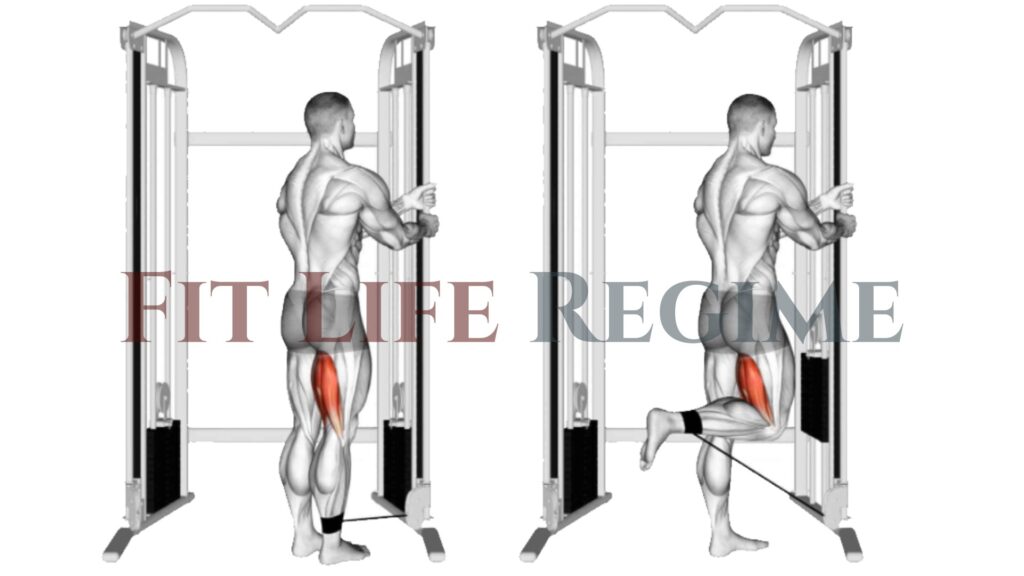
Muscles Worked
Primary: Hamstrings.
Secondary: Gluteals, Calf muscles.
How To Do Cable Standing Leg Curl
- Stand next to a machine that has a floor-level pulley. Attach the foot harness to a low pulley.
- With a foot harness on one ankle, grasp the support bar with both hands and step back with the other foot.
- The attached foot is slightly off the floor.
- Pull the cable attachment back by flexing the knee until the knee is fully bent.
- Return by straightening the knee to the original position and repeat.
- Continue with the opposite leg.
Tips
- Be careful not to sway at the hips. Maintain proper posture throughout the exercise.
- Focus on moving the weight with your hamstrings, utilizing a full range of motion.
10. Cable Glute Kickback
Cable kickback targets your gluteus maximus and improves both stability and toning to give you the shaped, toned look you desire.
It is an excellent isolation movement for targeting the glute and hamstring muscles.
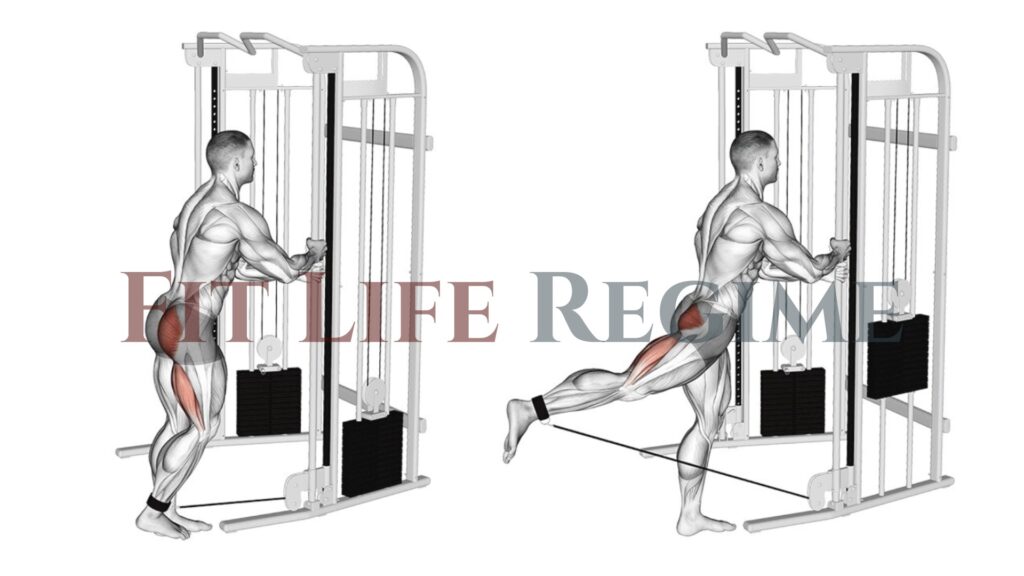
Muscles Worked
Primary: Gluteus Maximus
Secondary: Hamstrings
How To Do Cable Kickback
- Begin by strapping the ankle strap to your foot.
- With your feet together, grab onto the cable machine with both hands and lean forward with your back straight.
- Then, move your leg back until your glutes contract. Your leg should be slightly bent.
- Hold for one second, then slowly return to the starting position without placing your leg on the ground. This is one rep.
- Repeat for desired sets and reps. Repeat with the opposite leg.
Tips
- Keep an upright posture and ensure your leg always stays straight.
- Hold on to the cable machine to keep your body stable.
11. Kneeling Cable Hip Extension
The kneeling cable hip extension is an isolation exercise that builds muscle and strength in the glutes and hamstrings.
It’s an unconventional movement, but it’s very effective for building the lower posterior chain muscles.
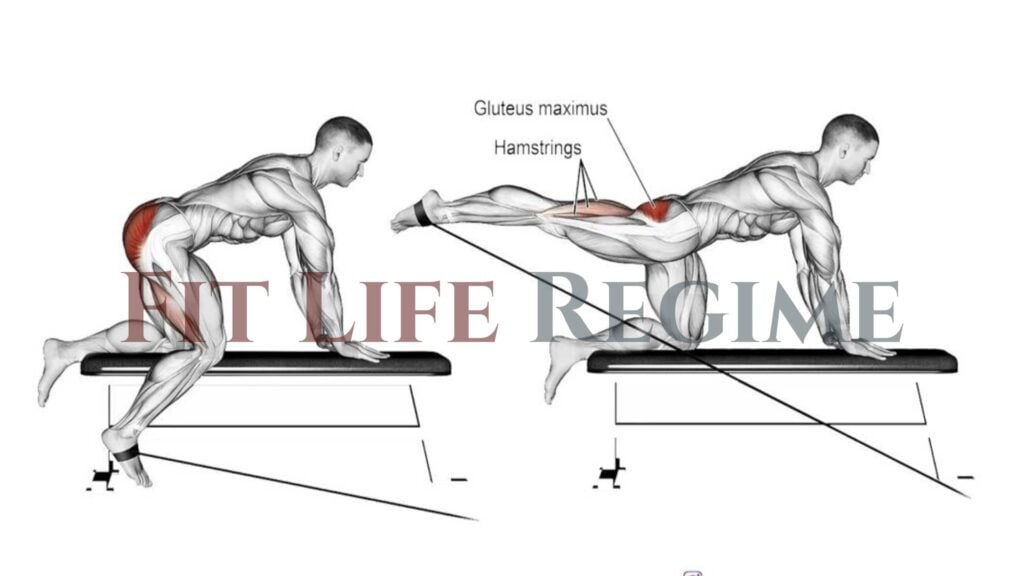
Muscles Worked
Primary: Gluteus Maximus
Secondary: Hamstrings
How To Do Kneeling Cable Hip Extension
- Place a bench on the left side of the cable pulley so your head is closest to the pulley.
- Attach an ankle cuff to the lowest notch on the cable pulley system, then to your right ankle.
- Kneel so your left knee is on the bench and hold on to the bench.
- Now, lift your right leg up and back as high as possible while squeezing your glutes. Keep your knee slightly bent.
- Then, lower your leg back down and inhale.
- Repeat the exercise with your opposite leg.
Tips
- Keep your back straight, your core tight, and your body still. Only your leg should move.
- Move slowly without any jerky motions while performing this exercise.
12. Cable Standing One Leg Calf Raise
Cable standing Single leg calf raises are one of the best ways of building your calf muscles.
It is a very effective isolation exercise that targets the Gastrocnemius and Soleus muscles.
If you don’t have a platform to perform the standing cable one-leg calf raise from, you can do it on the floor.
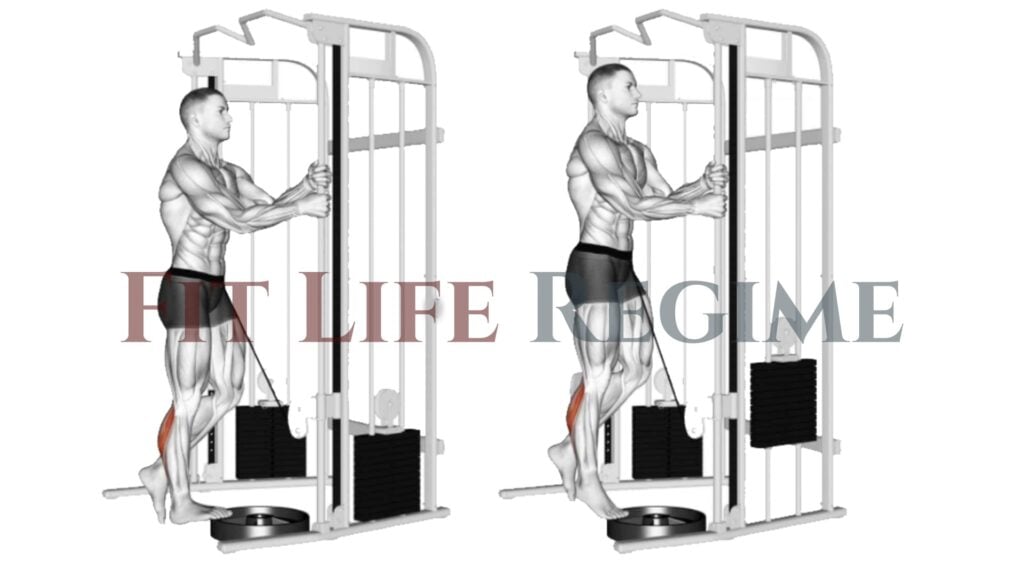
Muscles Worked
Primary: Gastrocnemius.
Secondary: Soleus.
How To Do Cable Standing One-Leg Calf Raise
- Place a cable belt or dip belt around the waist.
- Kneel before the low pulley and attach the belt to the cable.
- Stand on the calf block and grasp the support bar for balance.
- Position toes and balls of feet on calf block with arches and heels extending off.
- Raise heels by extending ankles as high as possible.
- Lower heels by bending ankles until calves are stretched.
- Repeat with your opposite leg.
Tips
- Keep the movement slow and under control.
- Do not lock out your knee.
13. Cable Standing Calf Raise
The Cable Standing Calf Raise helps strengthen and develop the calf muscles, which are crucial in ankle stability and lower leg power.
It is commonly included in leg workouts, lower body strength training, or as part of a calf-specific training routine.
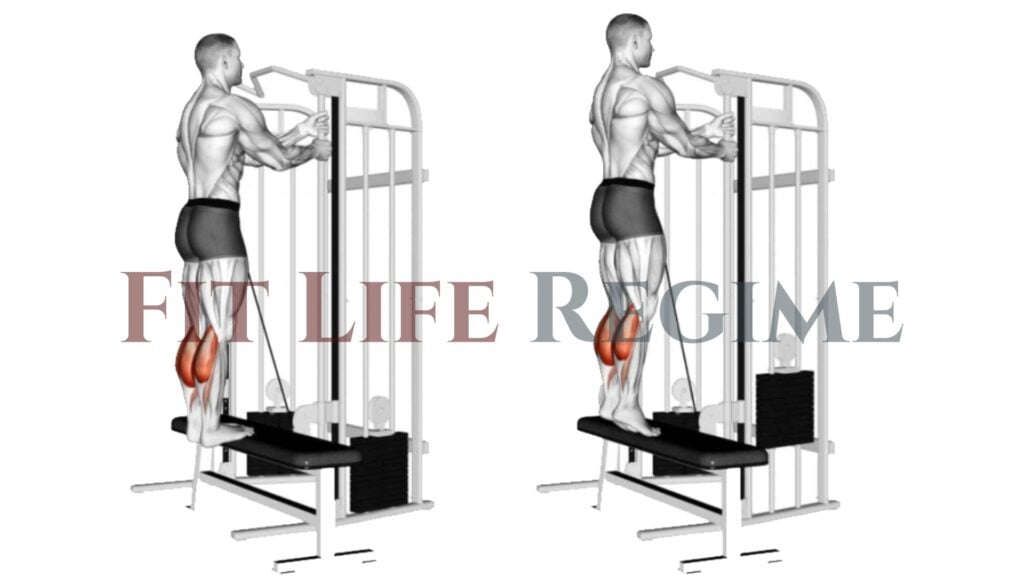
Muscles Worked
Primary: Gastrocnemius.
Secondary: Soleus.
How To Do Cable Standing Leg Calf Raise
- Start by setting up either a dip belt, rope, or straight bar on a low pulley cable machine and placing a bench in front of the machine.
- Step onto the bench with the balls of your feet on the edge and let your heels drop as far as possible.
- Then slowly raise your heels as far as possible, squeezing your calves and holding for a count.
- Return to the starting position.
Tips
- Pause and squeeze for a count of 1-2 at the movement’s top for added intensity.
- Keep the balls of your feet on the edge of the block/step. If you allow the balls of your feet to come in more, the exercise becomes easier.
14. Cable Hip Adduction
If the cable, hip adduction is a brilliant auxiliary exercise for toning your inner thighs.
You target the hip adductors of your strapped leg and significantly activate the hip adductors of your supporting leg, as they have to work hard to keep your body stable as you pull your strapped leg in.
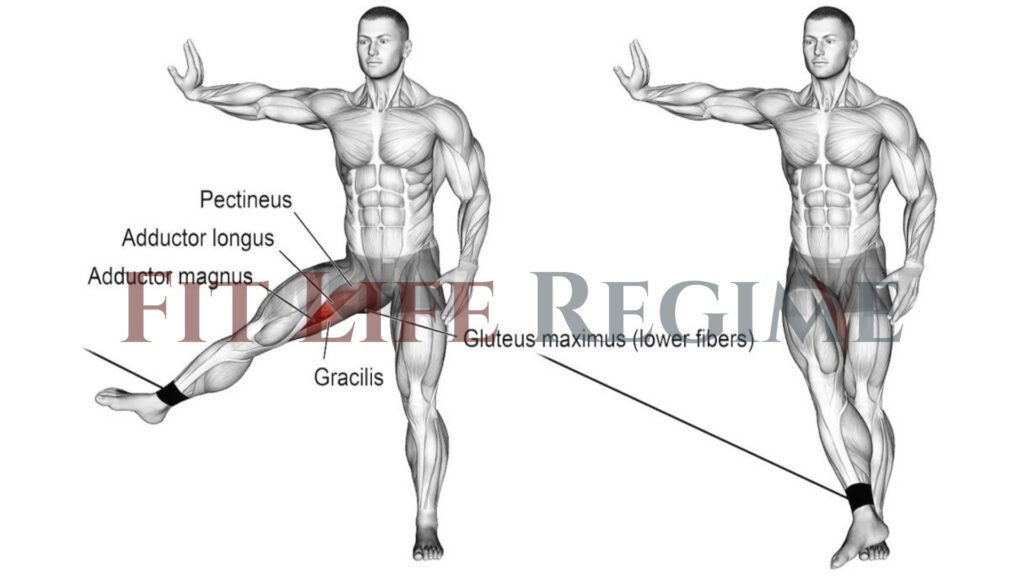
Muscles Worked
Primary: Adductor Magnus, Adductor Longus, Adductor Brevis
Secondary: Pectineus, Gracilis, Gluteus Maximus (lower fibers)
How To Do Cable Hip Adduction
- Stand with one side next to a low cable pulley.
- Attach the cable to the leg nearest the pulley using an ankle strap. Place the ankle strap around your ankle.
- Grab the opposite handle on the cable machine for stability.
- Chest up and shoulders back, you want a full range of motion.
- Swing your leg up and through until it’s in front of the strapped leg.
- Then, go back to the starting positions. Repeat for the desired repetitions and sets.
- Repeat the exercise with your opposite leg.
Tips
- Pause and squeeze for a count of 1-2 at the movement’s top for added intensity.
- Be sure to keep your body and legs straight.
15. Cable Hip Abduction
The cable hip abduction activates and builds your hip abductors, thus adding shape to your hips and producing more of an hourglass figure.

Muscles Worked
Primary: Hip abductors
Secondary: Gluteus Medius, Gluteus Minimus, Tensor Fasciae Latae
How To Do Cable Hip Abduction
- Start by standing next to the low cable pulley and attaching the ankle strap to the leg the farthest away from the pulley.
- Step away from the pulley so the cable is pulled taut and your strapped leg is pulled across your unstrapped leg.
- Grab hold of the cable machine for stability.
- Keeping your body and legs straight, pull the strapped ankle, away from the pulley until it is fully abducted and hold for two counts.
- Then slowly return your strapped leg to the starting position.
- Repeat with your opposite ankle.
Tips
- Keep your back straight and avoid leaning into the machine or towards the weight.
- Keep your working leg straight, with only a slight bend at the knee.
- Focus on a controlled lift and lower; don’t swing the weight with momentum.
- Keep your toes pointed forward.
How To Build Leg Cable (With Workout Routines)
Adding cable leg exercises to your workout routine is like adding other equipment to your routine.
Ensure that your workouts are well-rounded, with compound and isolation exercises that target all your leg muscles. This will also help boost your other larger compound lifts, such as deadlifts or squats.
However, the exercises you choose to spend your efforts on should correspond directly with what you need to work on for your particular goals.
Instead of just picking random exercises to work on, we’ve included exercises that address one or more of the following key points: improving muscle mass, strength, endurance, Power, and speed.
That way, you’re not wasting your efforts and building the specific attributes you need for your life. Win-win!
1. Set And Reps To Mass, Power, And Endurance
Do you care more about speed or endurance? Setting PRs in these particular exercises or building generally useable strength?
Once you’re clear, this table will help you work them into your routine:
| Goal | Recommended Sets/Reps |
|---|---|
| Mass | • 3-5 sets of 6-10 reps • Rest 60 seconds to 2 minutes between sets |
| Pure Strength | • 4-8 sets of 1-5 reps • Rest 2-3 minutes between sets |
| Endurance | • 2-5 sets of 12-25 reps • Rest 60-90 seconds between sets |
| Power and Speed | • 3-5 sets of 3-5 reps (but it will depend on when your explosiveness starts to fail) • Rest at least 2 minutes between sets |
2. Select Weekly Workout Volume
The volume of your workout program refers to the number of sets, reps, and exercises performed in each workout.
A good starting point is to perform 3–4 sets of each exercise for 8–12 reps.
- Beginners (with a year or less of training) should aim for about 12 weekly sets.
- An Intermediate trainee (with two to four years of training) can increase the volume to 16 sets per week.
- An advanced trainee (with four or more years of training) may be able to complete up to 20 weekly sets.
When a certain amount of volume stops working and your progress stalls, you can add sets to increase the volume and use that to make progress again.
3. Weekly Frequency
How often you perform leg workouts depends on your fitness level and goals.
- For beginners, 1-2 leg workouts per week are recommended
- While advanced lifters may benefit from 2-3 leg workouts per week.
To be effective, the load should bring you to or near failure within the given rep ranges.
Beginner Cable Leg Workout Routine
| Exercise | Sets | Reps | Rest (between sets) |
|---|---|---|---|
| Cable Squat | 4 | 8-10 | 60-90 seconds |
| Stiff-Leg Cable Deadlift | 4 | 8-12 | 60-90 seconds |
| Cable Pull-Through | 3 | 12-15 | 60-90 seconds |
| Cable Standing Calf Raise | 3 | 15-20 | 60-90 seconds |
Cable Leg Workout Plan
| Exercise | Sets | Reps | Rest (between sets) |
|---|---|---|---|
| Cable Deadlift | 4 | 8-10 | 60-90 seconds |
| Cable Front Squat | 3 | 6-8 | 60-90 seconds |
| Standing Cable Leg Curl | 3 | 8-12 | 60-90 seconds |
| Cable Standing One Leg Calf Raise | 3 | 10-15 | 60-90 seconds |
Intermediate Leg Cable Workout Routine
| Exercise | Sets | Reps | Rest (between sets) |
|---|---|---|---|
| Cable Squat | 4 | 8-10 | 60 Sec |
| Cable Lunges | 4 | 12-15 | 60 Sec |
| The Cable Kick Back | 3 | 10-12 | 60 Sec |
| Cable Standing Calf Raise | 3 | 15-20 | 60 Sec |
Leg Muscle Anatomy
The leg is divided into the upper leg (thigh) and lower leg (calf).
The legs also consist of dozens of muscles that flex, bend, extend, adduct, abduct, and rotate your legs and allow movement.
This ultimate cable leg exercise will focus on four main muscle groups: the quadriceps, hamstrings, glutes, and calves.
Understanding how they all fit together and work with each other will ensure you get the most out of your cable leg workout.

Quadriceps
The quadriceps femoris, located in front of the thigh, has four separate heads: 1. Vastus medialis 2. Rectus femoris 3. Vastus lateralis 4. Vastus intermedius
Hamstrings
The hamstrings, located behind the thigh, are a group of three muscles that originate from the ischium bone of the pelvis: Biceps femoris, Semimembranosus, Semitendinosus
Gluteals
The gluteus maximus arises from a large area on the rear of the pelvic bone, passes down behind the hip joint, and attaches to the upper femur. This powerful muscle causes hip extension.
Calves
The lower leg contains 10 different muscles, and the calf comprises two muscles: The gastrocnemius and Soleus.
Other thigh muscles include the following: Hip adductors (Inner thigh), hip abductors, hip flexors.
This blog contains detailed descriptions of all major cable leg exercises focusing on the quadriceps, hamstring, glutes, and Calf muscles.
The cable leg exercises are divided into squats, cable deadlifts, cable lunges, and calf raises.
FAQs
Best Cable machine quad exercises
- Cable Squats
- Cable Lunges
- Cable Leg Press
- Cable Step-ups
- Cable Front Squats
- Cable Split Squats
- Cable Bulgarian Split Squats
- Cable Sumo Squats
- Cable Leg Extensions
- Cable Hack Squats
Are Cable Leg Exercises Effective?
Yes, cable leg exercises are a great addition to any fitness routine. They are perfect if you are really focused on building muscle or are a beginner looking to perfect form safely.
The cable machine will allow you to maintain good form and reduce the stress on the joints, allowing you to hone in on the muscles you target with quality reps.
Are cable machines effective for leg strength?
The cable machine is great for working your legs. They allow you to hit your legs from various angles that better engage your lower body muscles than barbells and dumbbells.
Are you able to perform squats with a cable machine?
Yes, you can do squats with a cable machine. Indeed, squats on a cable pulley machine are more effective for building quads than any other version. That’s because you can involve the quads more directly while also removing stress from the lower back.
Are leg extensions possible with cables?
Yes, you can perform leg extensions with cables. To perform this exercise, you must place in front of the cable machine and put ankle straps on the end of the cable. You will then be able to work on each leg independently.
How do you use leg cables at the gym?
When training the four major muscle groups in the legs, you should include squats, deadlifts, lunges, calf raises, and hip extensions.
These four main exercises target your quads, hamstrings, calves, and glutes.
Choose 4-5 exercises from the above listed and train each and every muscle group of the lower body.
Takeaways
The cable machine is the most versatile piece of exercise equipment. This machine allows you to get a great workout for every muscle group in your body.
The cable machine is often praised for working the upper body, but it can do much more than sculpt your shoulders, arms, back, and chest. Many people, like you, also love the cable machine for targeting all the lower-body muscle groups.
Cable exercises for the legs target the quadriceps, glutes, hamstrings, and calf muscles from a range of angles without compressing the spine.

Manish is a NASM-certified fitness and nutrition coach with over 10 years of experience in weight lifting and fat loss fitness coaching. He specializes in gym-based training and has a lot of knowledge about exercise, lifting technique, biomechanics, and more.
Through “Fit Life Regime,” he generously shares the insights he’s gained over a decade in the field. His goal is to equip others with the knowledge to start their own fitness journey.
